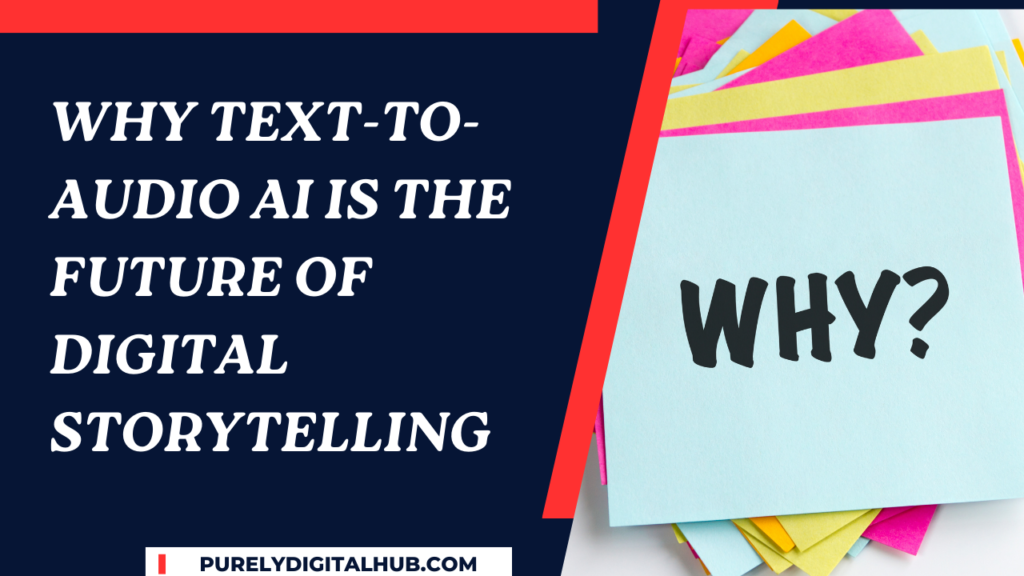In a world where technology keeps redefining the face of information consumption, digital storytelling-from static text and images to increasingly dynamic and interactive forms-continues to evolve. Among these innovations, text-to-audio AI stands out because it’s a game-changing tool bound to shape the future of storytelling. This transforming technology offers new dimensions in audience engagement, access, and content delivery, making it an indispensable tool for both creators and businesses alike.
The Rise of Audio Content
Audio content is seeing a growth in popularity like never before. Recent studies show that a vast majority of US consumers, more than 60%, are tuning into digital audio every week, be it podcasts, audiobooks, or other forms of spoken-word content. This jells with a wider trend for media towards multitasking-friendly formats that can fit around busy lifestyles. Text-to-audio AI seamlessly integrates into this trend, where creators can change written content into high-quality audio formats with literally minimal effort.
Think of a blog post that can be converted into a professional-sounding narration, or even a short story turned into an audiobook. These things are no longer solely in the domain of big publishing houses but are quite within the reach of everybody who has the right tool. Thus, by using this technology, storytellers are able to plug into the burgeoning demand for audio experiences.
Improved Accessibility and Inclusivity
One of the most important benefits of text-to-audio AI is that it can break down some of the barriers to information. An estimated 2.2 billion people in the world have some kind of visual impairment, and for the most part, traditional text-based content excludes these audiences. By turning text into audio, creators make sure their stories reach a bigger audience and foster inclusivity and equal access to information.
Audio formats also accommodate a lot of readers who have issues with reading comprehension or learning disabilities, such as dyslexia. In addition, such an option allows users to choose either text or audio, whatever medium works best for their needs in what is an inclusive storytelling experience.
The Power of the Human Voice
Of course, stories can always invoke emotions, but behind it is a voice that can really make a difference. AI in text to audio has reached such a point where it can imitate human inflection, pacing, and emotion. Those days are long gone when one hears robotic voices. AI narrations sound so natural that storytellers can even create deeper emotional connections with their audience.
For instance, a travel blogger may add more value to his or her audience by adding an audio narration to their feelings of excitement and wonder. Similarly, brands can have customer success stories narrated by AI voices, making the content more relatable and engaging. This is where audio storytelling trumps text.
Cost-Effective and Scalable Creation of Content
Traditional recording requires hiring voice talents, booking a studio, and then post-production editing-a very time-consuming and costly affair. Text-to-audio AI removes all these obstacles at cost-effective solutions while never compromising on quality.
With a few clicks, creators can transform their content into audio, making it easier to scale their storytelling efforts. Whether you’re a solo blogger or a multinational corporation, this technology empowers you to deliver consistent and high-quality audio experiences to your audience.
Multilingual Storytelling at Scale
With digital content being highly global, often, storytellers have to have an appeal for diverse audiences with multilingual needs. Text-to-audio AI solves this by seamlessly translating and offering voiceovers in a variety of multiple languages. This will definitely enable creators to reach out to wide audiences beyond the barriers set by culture and language.
For example, a U.S.-based content creator can have AI create Spanish, French, or Mandarin audio versions of their stories to reach new markets and drive global engagement. This scalability ensures that no story is lost in translation.
Integration with Emerging Platforms
While this domain is continuously evolving unto itself, the future direction may increasingly cross over with emerging technologies such as Virtual and Augmented Reality. Text-to-Audio AI fits well into such platforms since it enhances interactive immersive experiences for stories.
Think about experiencing a world of fantasy in VR, while an AI-generated narrator takes one through the story. Or an AR app might lay narration over real-world environments, bringing history alive in a museum or on a city tour. These applications are but two examples of what’s possible with text-to-audio AI and new forms of storytelling.
The Future of Marketing and Branding
Branded storytelling is being embraced by brands into their marketing strategies at a very fast pace, and that is where text-to-audio AI plays an important role. It helps the brand tell their story in a more personal and engaging way, creating an even better relationship with their target audience.
For instance, brands can use AI to create branded podcasts, audio case studies, or audio ads that speak much more effectively and deeper to listeners. An AI ad maker can further enhance this strategy by generating highly personalized and engaging ads tailored to different audience segments. This ensures that brands deliver compelling messages that resonate deeply with listeners, driving higher engagement and conversions. By embedding text-to-audio AI into their content strategies, brands will be ahead of the curve and create long-term relationships with their customers.
Conclusion: Embracing the Audio Revolution
AI to audio is not a fad; it’s a transformative force for the future of digital storytelling. Unlocking unparalleled opportunities for creators and brands alike, this technology enables new ways of improving accessibility, creating emotional connections, and unlocking multilingual possibilities at scale.
While audio content is going through a boom in the digital space, the adaptation of text-to-audio AI has stopped being about optionality; it is more about necessity now. Embracing this innovation empowers storytellers with the ability to make their voice heard, let their stories be shared, and mesmerize their audiences beyond imagination.
